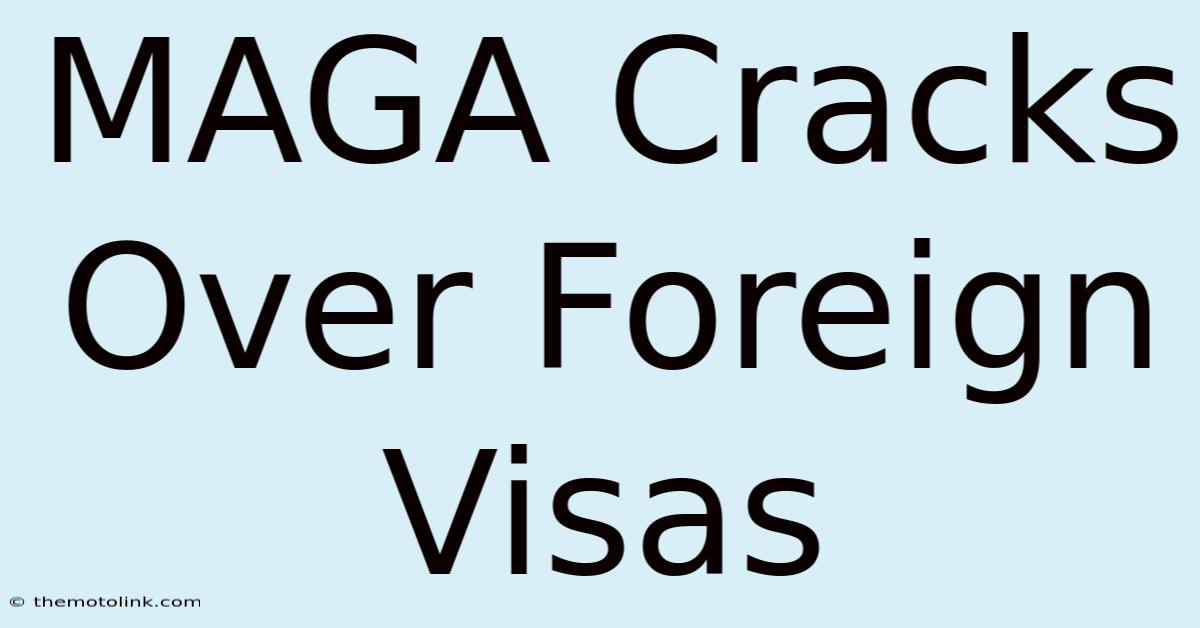MAGA Cracks Over Foreign Visas

Discover more detailed and exciting information on our website. Click the link below to start your adventure: Visit Best Website nimila.me. Don't miss out!
Table of Contents
MAGA Cracks Over Foreign Visas: A Divided Base and the Future of Immigration Policy
Meta Description: The MAGA movement faces internal divisions over foreign visas. This article explores the conflicting viewpoints, the impact on immigration policy, and potential future outcomes. #MAGA #Immigration #Visas #PoliticalDivisions
Introduction:
The "Make America Great Again" (MAGA) movement, a powerful force in American politics, is experiencing significant internal fracturing over the issue of foreign visas. While a core tenet of MAGA has historically been stricter immigration control, the nuances of visa policies are proving far more complex than initially presented, exposing divisions within the movement itself. This article delves into the growing discord, exploring the different factions and their arguments, and examining the implications for future immigration policy in the United States.
Section 1: The Traditional MAGA Stance on Immigration
The traditional MAGA stance on immigration has largely centered on restricting both legal and illegal immigration. This often includes calls for increased border security, stricter enforcement of existing laws, and reductions in legal immigration quotas. The belief is that uncontrolled immigration negatively impacts the American economy, job market, and national security. This perspective often frames immigration as a zero-sum game, where the gains for immigrants are seen as losses for native-born citizens. Key arguments focus on the potential strain on social services, infrastructure, and cultural identity. However, this simplistic view is increasingly being challenged from within the movement itself.
Section 2: The Emerging Pragmatist Wing: The Need for Skilled Workers
A growing faction within the MAGA movement recognizes the critical need for skilled foreign workers to fill labor shortages in key sectors of the American economy. Industries such as technology, healthcare, and agriculture are facing significant labor gaps, and these pragmatists argue that restricting visas for these skilled professionals would negatively impact economic growth and competitiveness. They advocate for a more nuanced approach, focusing on merit-based immigration systems that prioritize individuals with in-demand skills and qualifications. This group often points to the successes of other nations that have successfully integrated skilled immigrants while maintaining robust border security. For example, Canada's point-based immigration system is often cited as a successful model.
Section 3: The Internal Conflict: Balancing Security with Economic Needs
The central conflict within the MAGA movement stems from reconciling the desire for stronger border security with the economic need for skilled foreign workers. This tension is evident in debates surrounding H-1B visas for high-skilled workers and other specialized visa programs. Some argue that these programs are exploited, leading to displacement of American workers, while others contend that they are essential for attracting and retaining top talent. This internal debate reflects a broader struggle within the conservative movement to find common ground between its traditional protectionist wing and a more economically pragmatic one. The lack of consensus on these issues is leading to internal strife and weakening the movement's overall message on immigration.
Section 4: The Impact on Policy and Future Predictions
The internal disagreements within MAGA regarding foreign visas are likely to continue shaping the political landscape. The lack of a unified stance weakens the movement’s ability to effectively influence immigration policy. This could lead to a more fragmented and less effective approach to immigration reform, potentially hindering efforts to address both security concerns and economic needs. Future policy outcomes may depend on which faction gains more influence within the movement and the broader political environment. The outcome could range from more restrictive visa policies to more nuanced, merit-based systems. The current situation suggests a period of uncertainty and ongoing internal debate.
Conclusion:
The fracturing within the MAGA movement over foreign visas highlights the inherent complexities of immigration policy. The simplistic narratives of the past are giving way to a more nuanced understanding of the economic and social benefits and challenges of immigration. The future direction of immigration policy in the United States will depend heavily on how these internal divisions are resolved within the MAGA movement and the broader political landscape. What are your thoughts on the future of immigration policy in light of these internal conflicts? Share your opinions in the comments below!
(Suggested Images):
- A split image representing the two factions within the MAGA movement on immigration.
- A graph depicting the number of H-1B visas issued over the past decade.
- An infographic comparing different countries' immigration policies.
(Suggested Internal Links):
- Article on the history of the MAGA movement.
- Article on the impact of immigration on the US economy.
(Suggested External Links):
- A report from the Migration Policy Institute on skilled worker immigration.
- A government website detailing current US visa policies.
(FAQ with Schema Markup):
{
"@context": "https://schema.org",
"@type": "FAQPage",
"mainEntity": [{
"@type": "Question",
"name": "What is the traditional MAGA stance on immigration?",
"acceptedAnswer": {
"@type": "Answer",
"text": "The traditional MAGA stance generally favors stricter immigration controls, increased border security, and reduced legal immigration quotas."
}
},
{
"@type": "Question",
"name": "Why are there divisions within MAGA on visa policies?",
"acceptedAnswer": {
"@type": "Answer",
"text": "Divisions stem from balancing the desire for stronger border security with the economic need for skilled foreign workers, creating internal conflict on issues like H-1B visas."
}
}]
}

Thank you for visiting our website wich cover about MAGA Cracks Over Foreign Visas. We hope the information provided has been useful to you. Feel free to contact us if you have any questions or need further assistance. See you next time and dont miss to bookmark.
Featured Posts
-
Texas A And M Vs Usc Football History
Dec 28, 2024
-
Nyt Connections Answers December 28
Dec 28, 2024
-
Manhattan Market Fire Update
Dec 28, 2024
-
Cbs Broadcaster Greg Gumbel Dead At 78
Dec 28, 2024
-
Horvath Navy Edge Out Ou Football
Dec 28, 2024
